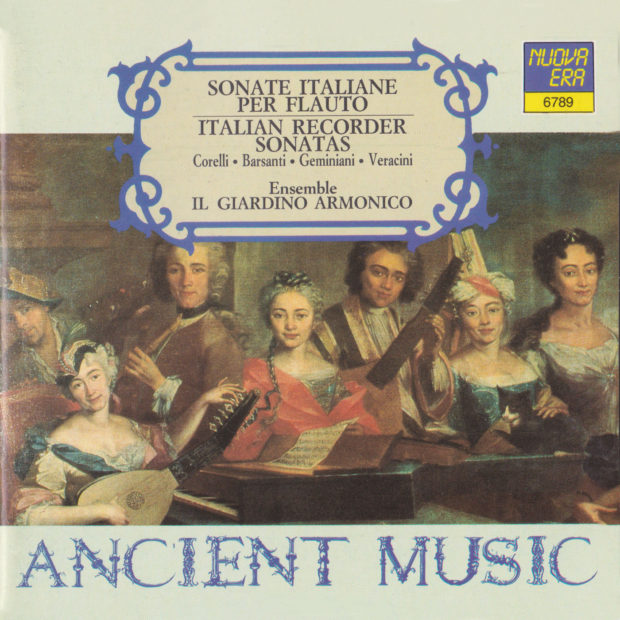ARCANGELO CORELLI • FRANCESCO BARSANTI FRANCESCO GEMINIANI • FRANCESCO VERACINI SONATE PER FLAUTO DOLCE • ITALIAN MUSIC IN LONDON
“In those times there were still few pieces actually composed for the flute. Generally one had to make to with oboe or violin pieces and arrange them for one’s own use as best one could.” The statement by Johann Joachim Quantz (1697-1773) gives us an idea of the way eighteenth century performers found no difficulty in adapting music that had been destined for another instrument to their own instruments and their own needs. The practice was also encouraged by the music publishers, who, wishing to attract the widest possible interest in their publications, often gave poly-instrumental indications on the fronterspiece of a work: in English “for the flute, hautboy or violin…”, and in French “pour la musette, viele, flute-à-bec, traversiere, hautbois…”.
John Walsh of London published in 1702 and 1707 adaptations for the recorder of some of the Sonatas taken from Arcangelo Corelli’s famous opera V, Sonatas for violin and basso continuo (Roma, “I gennaro 1700”), thus increasing the repertoire for recorder, an instrument which then enjoyed great popularity, especially among amateur musicians. The demand for music for the recorder must have been so great in London that Walsh even went on to publish an arrangement for recorder consort of Corelli’s op. VI Concerti Grossi, thus enabling those who played this instrument, who were at this time probably more numerous in England than violinists, to get to know the music of the Italian composer, who had won such fame all over Europe. While Corelli’s violin music was thus becoming a part of the repertoire of English recorder players at the beginning of the eighteenth century, in the year 1714 three Italian virtuosi arrived in London: the violinsts Francesco Geminiani and Francesco Maria Veracini and the flautist and oboist Francesco barsanti. There is a sort of biographical and musical link between the four musicians represented on this disc. Geminiani was a pupil of Corelli, held to be the greatest exponent of formal perfection and likewise, had transcribed the maestro’s op.V in the form of Concerti Grossi. Francesco Barsanti, a contemporary of Geminiani and like him a native of Lucca, travelled to London with him, becoming flautist and oboist at the Italian Opera in the years when Francesco Maria Veracini was the first violinist (1714-1715).
The rivalry that existed between Geminiani and Veracini was well known, and it is said that the latter’s departure from London was the result of an alleged instrumental inferiority compared to the violinist of Lucca. Both Geminiani and Barsanti cultivated the genre of the Concerto Grosso (which had received a significant contribution in Corelli’s opera VI) and extended its instrumental scope: the former adding parts to the “concertino” group and the latter introducing the oboes, trumpets and timpani. At the end of his violin sonatas Corelli placed a series of variations on the Folio bass, most used by composers such as B. Pasquini, A. Vivaldi, J. S. Bach, C. P. E. Bach and in more recent times by S. Rachmaninov (1932). Corelli’s twenty two variations alternate characters (“affects”), that are now contrasting, now complementary, where the bass is often freed of its pure role as an harmonic support to the melody, blossoming into variations of great instrumental virtuosity. The two Sonatas, number five in C minor (originally in G minor) and number four in F major, belong to the first part of opera V and may be defined as Church Sonatas, characterised by a second movement with fugai treatment and a final movement in ternary time of a gigue. The Second Sonata by Francesco Barsanti is quite different in spirit and belongs to the collection of “Sonate a Flauto o Violino solo…” published in London with a dedication bearing the date 8 april 1724. In the classic scheme of Coralli, four movements (slow, quick, slow, quick), this Sonata opposes a first Adagio movement of “Galant” style, with original ornamentations of the composer, rich in syncopation, appoggiatura and triplets, to a third movement (Largo), in which the dotted bass in a high compass is reminiscent of the more antique style of French violists.
The Sonata which is uncertainly attributed to Francesco Geminiani was published in London in 1723, described as “fitted to the German flute”, and here we perform it with a deeper instrument, the one used for the other Sonatas, the Voice Flute. This type of recorder, used almost exclusively in England, is fixed in D, and thus makes it possible to perform music written for the flute (which also has D as its lowest note), without recourse to the transcription that was usual when using the treble recorder in F (the main instrument in the family), according to the indications given by Hotteterre, Telemann and others. The Voice Flute fell into disuse, along with the entire family of recorders, on account of their weak volume and their limitated dynamic possibilities, unlike the transverse flute which was soon to replace them completely. The manuscript of the “Sonata a Violino o Flauto solo e basso” by Francesco Maria Veracini “Fiorentino”, bears the date “Venezia, 26 luglio 1716”; the sixth Sonata presents the rather unusual sequence of three quick movements, of differenting styles, preceded by an introductory Largo. We should finally note that in the transcriptions of Corelli’s music in Barsanti’s and Veracini’s collections of the same period, especially those of Italian musicians (Bonocini, Mancini, Bitti, etc.), the music was often set both for violin and for recorder, almost as though the two instruments were in some sense seen as being similar in the culture of that time.

